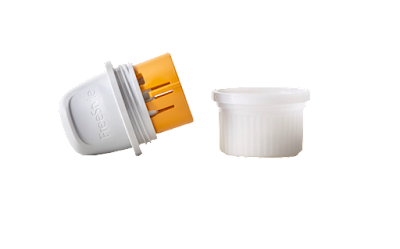Today, Abbott received FDA approval for the Freestyle Libre 3 model. When reporters asked, Abbott said it will become available later in 2022, but did not elaborate further. Abbott's press release on the topic (see footnote #5) said "At this time, FreeStyle Libre 3 is not currently eligible for Medicare reimbursement, and Medicaid eligibility may vary by state." Abbott explains its Medicare situation at https://www.freestyle.abbott/us-en/medicare.html. That said, Abbott could attain CMS/Medicare coverage at a later date. Also unclear is whether Libre 3 received the iCGM designation as the Libre 2 did. It was expected, but unclear in the press release that came out today.
The pricing for Libre 3 will reportedly match that of the previous model the Libre 2 (meaning it will be 30% cheaper than Dexcom), but will match most of the key points of differentiation which Dexcom currently enjoys, including continuous real-time glucose readings automatically delivered to a person's smartphone each minute, although I'm unsure if that uses up your mobile phone's battery life faster (by comparison, the Dexcom G6 provides readings every 5 minutes), and the FreeStyle Libre 3 system was cleared for use with the FreeStyle Libre 3 iOS and Android mobile apps, which enable users to view their glucose levels in real time, track their glucose history and trends, and set up optional alarms plus notifications to help them be alerted of serious medical events like hypoglycemia. Recall that last June (2021), I opined I might be willing to switch to Libre 3 when it comes out given frustrations I've experienced with Dexcom and the fact that I feel the company presumes it will always enjoy my business (see my post at https://blog.sstrumello.com/2021/06/should-i-say-adios-to-dexcom-g7-hello.html for details).
Libre 3 calls itself the world's smallest, thinnest glucose sensor (the size of two pennies stacked on top of one another) that can be worn up to 14 days to deliver continuous, real-time glucose readings. I'm not sure how well the adhesive holds for 14 days, but the tiny size certainly helps it remain attached. The Libre 3 does require a 60-minute warm-up. By comparison, the new Dexcom G7 model will only require a 30-minute warm-up (so half the time). But the Dexcom G7 sensors will still only last 10 days, compared to 14 days for the Libre 3 model, so that trade-off is one cost-conscious patients may consider worthwhile. After all, that means they'll spend less money with the Libre 3 system than they will with Dexcom G7. Patients with healthcare plans with deductibles might notice the lower costs, although both companies have been working to secure more widespread coverage of their products pre-deductible. The insertion device is shown below. It's considerably less complicated than rival Dexom's insertion device is.
The sensor and transmitter is combined in both the Freestyle Libre 3 and Dexcom G7 models in an all-in-one sensor/transmitter insertion. 
By comparison, the size of the rival Dexcom G7 is considerably bigger than Libre 3, being about the size of three quarters stacked on top of one another (compared to 2 pennies stacked atop one another for Abbott Freestyle Libre 3). Still, because of the smaller size and different shape, the new Dexcom G7 can be inserted on the back of the upper arm, the abdomen, or, for children ages 2-17, on the upper buttocks.
The accuracy of glucose monitors (particularly continuous glucose monitoring systems) is typically described with a metric called "MARD", or mean absolute relative difference. MARD is listed as a percentage, describing how far off you can expect your sensor reading to be from your actual plasma blood glucose level. Generally, this means that the lower the percentage, the more accurate the sensor. If MARD was zero, there would be NO difference between plasma blood glucose and sensor values, hence the lower the MARD percentage (closer to zero), the more accurate it is.
As for accuracy, the FreeStyle Libre 3 has a MARD of 7.9% at 14 days of use and is the first device to have a MARD of less than 8%. By comparison, the Dexcom G7 has a MARD of 8.2% for those wearing the device on their upper arm. In reality, the differences in accuracy between Abbott Freestyle Libre 3 and Dexcom’s new G7 models are marginal and one cannot really say either CGM is significantly more or less accurate. In fact, the difference could well be attributed to the math and statistical calculations from the trial sample sizes for each company, and not because one is any more or less accurate than the other.
Libre 3 Will Be Priced 30% Less Than Dexcom G7
Abbott Freestyle Libre 3 will also continue to be 30% less costly than rival products (e.g. Dexcom). That strategy began with the Libre 2 model, although that model lacked all the features the new Libre 3 model has. Still, according to Abbott, patients with commercial insurance can expect to generally pay between $0 and $60 per month for sensors. Abbott is pricing the product aggressively in the U.S. hoping to lure Dexcom users away, although its lack of Medicare coverage remains a key limitation for Libre 3. But if Libre 3 is successful in the commercial insurance market, we can expect it to pursue the Medicare market. Time will tell on that.
Below are some relevant articles worthy of reading.
https://www.medtechdive.com/news/abbott-libre-3-CGM-fda-clearance/624591/
https://www.prnewswire.com/news-releases/abbotts-freestyle-libre-3-receives-us-fda-clearance--features-worlds-smallest-thinnest-and-most-accurate-14-day-glucose-sensor-301557561.html
https://www.abbott.com/corpnewsroom/strategy-and-strength/freeStyle-libre-3-worlds-smallest-sensor-is-here.html
https://www.abbott.com/corpnewsroom/strategy-and-strength/freestyle-libre3-welcome-to-the-us.html





























No comments:
Post a Comment